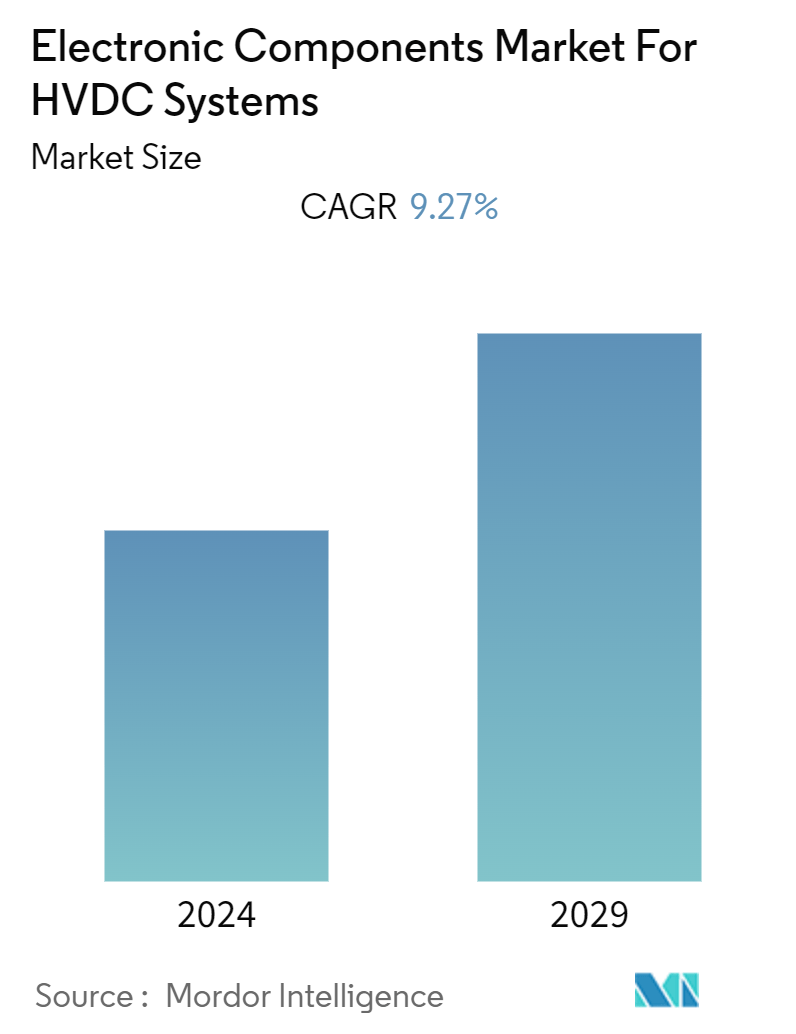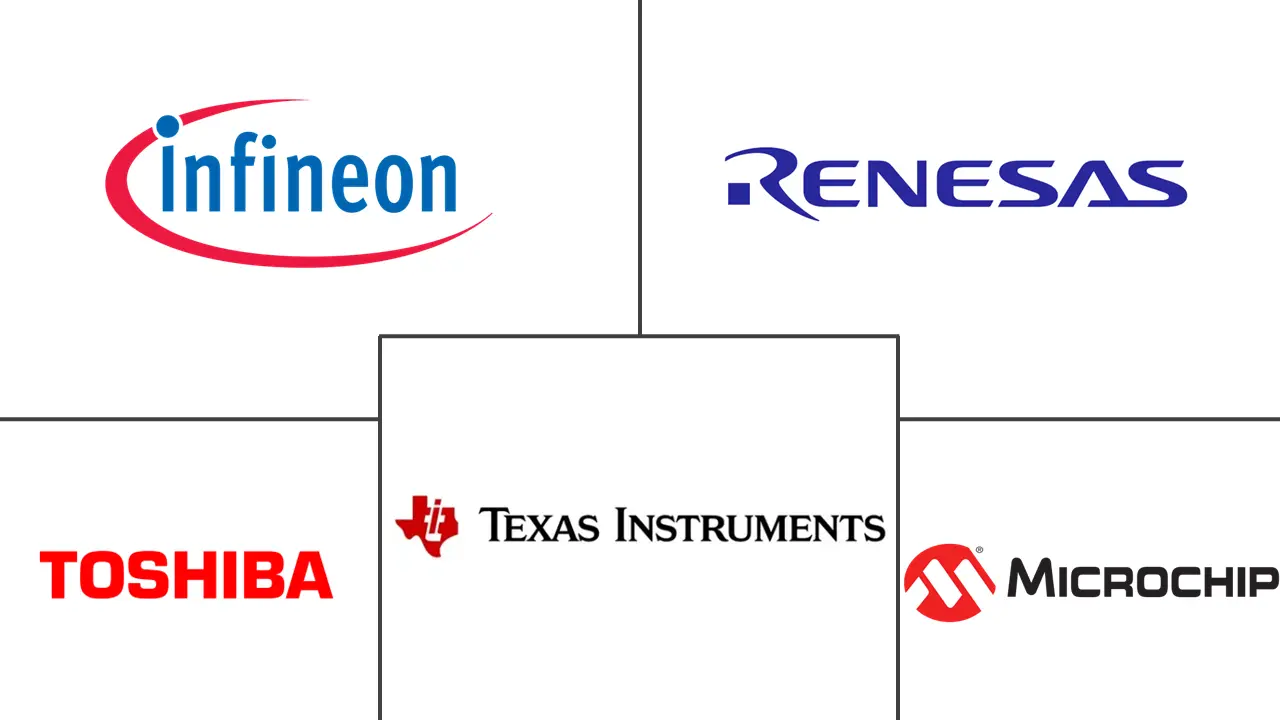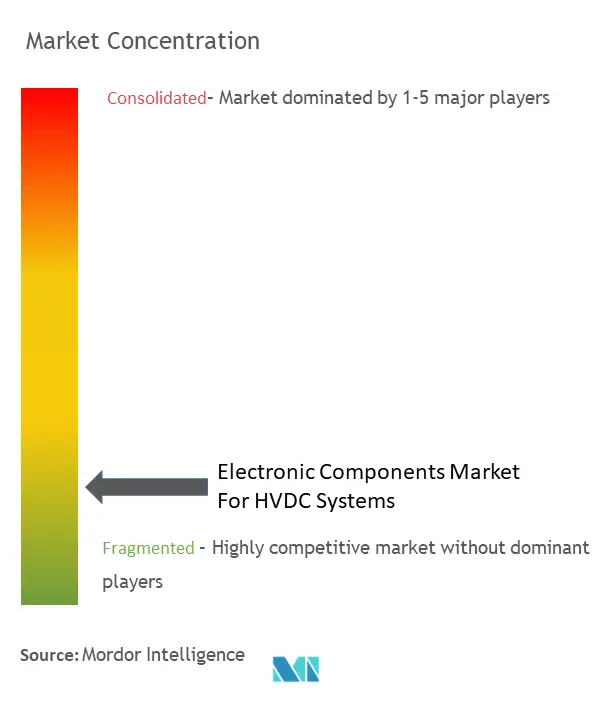Electronic Components for HVDC Systems Market Size

| Study Period | 2019 - 2029 |
| Base Year For Estimation | 2023 |
| CAGR (2024 - 2029) | 9.27 % |
| Fastest Growing Market | Asia Pacific |
| Largest Market | Asia Pacific |
| Market Concentration | Low |
Major Players
*Disclaimer: Major Players sorted in no particular order |
Electronic Components for HVDC Systems Market Analysis
The Electronic Components Market For HVDC Systems Industry is expected to register a CAGR of 9.27% during the forecast period.
High Voltage Direct Current systems, abbreviated as HVDC systems, transfer direct current for electricity transmission over long distances. They are often referred to as Superhighway or Power Superhighway. HVDC lines improve the efficiency of transmission lines and enable rapid energy transmission.
- HVDC systems are gaining momentum across the wind and solar power plants owing to HVDC technologies providing power flow control, rapid stability control, and ability to segment parts of the power system which can improve the grid's reliability, flexibility, and resilience.
- HVDC systems are also deployed in submarine and subterranean applications where overhead lines are unfeasible, and HVAC has higher electrical losses. HVDC submarine cables possess reactive power components. Thus, it does not have the physical restrictions that AC cables have. This allows underwater transmission lines to connect to asynchronous networks and offshore solar/wind power plants. The government's efforts to transmit energy from one country to another through subsea HVDC transmission lines create demand for electronics components such as IGBT, thyristors, and capacitors.
- The rapidly growing advanced HVDC transmission projects worldwide, particularly in Europe and Asia, drive market growth. The German government has established a framework for further developing offshore wind energy capacities in Germany with the Wind Energy at Sea Act. Accordingly, the installation capacity is to reach 30 gigawatts by 2030 and up to 70 gigawatts by 2045. More powerful high-voltage direct current transmission systems must also be built to transport electricity over long distances.
- The ongoing economic downturn, Russia-Ukraine war, geopolitical tensions, increasing electricity prices, high-interest rates, and growing inflation are anticipated to challenge the market's growth.
Electronic Components for HVDC Systems Market Trends
Capacitors to be the Fastest Growing Passive Component
- An HVDC capacitor is considered one of the core components of the HVDC transmission system. It plays a crucial role in converting AC current to DC current, transporting power between HVDC convertor stations, and further changing the DC current back to AC to feed the electricity into the power grid. It significantly helps improve power quality, maintain voltage stability, and control power flow instantly, along with decreasing the possibility of short-circuiting current by swiftly managing the power flow in the transmission lines. An increased focus on utilities to avoid overload conditions, enhancing power flow between parallel lines, and the need for improving the system's stability is further increasing the adoption of power capacitors in HVDC transmission systems.
- Various HVDC capacitors include aluminum electrolyte capacitors, ceramic capacitors, glass capacitors, plastic film capacitors, reconstituted mica capacitors, and wet tantalum capacitors. Paper capacitors were one of the first types sold on the market. They are mainly made by sandwiching two sheets of aluminum foil with paper soaked in mineral oil. The product's entire assembly is rolled up, wire leads are attached to the aluminum foils, and the package is sealed with wax before being placed inside a cylindrical cardboard case.
- As renewable energy continues to surge worldwide, advancements in power capacitor technology, including flat winding technology, further contribute to efficient power transmission, lower transmission losses, and better energy savings. For instance, TDK's flat winding technology employed in its MKK DCi-R power capacitors facilitates a volume fill factor of about 95%, with a majority capacitance exceeding 10,000 microfarads, indicating a tremendous efficiency in storing electric charges. This energy density is about 10% higher than other technologies.
- Considering the working principle of flat winding technology, it first winds the conductive metalized foils and insulates dielectric films to form thousands of alternating capacitor layers. Further, the volume fills factor of a capacitor refers to how completely the case is filled with the capacitor, followed by further pressing the cylindrical winding into a nearly rectangular shape to save space in a stainless-steel case with very high energy density.
- According to EIA, In 2023, the United States saw a dip in its fossil fuel consumption, dropping to 77.18 quadrillion British thermal units from the previous year's 78.5 quadrillion. Conversely, renewable energy consumption in the U.S. saw a modest uptick, hitting 8.24 quadrillion British thermal units.
- With many characteristics enclosed, design engineers are essentially adopting this and other new power capacitor technologies for HVDC projects throughout regions such as Europe, the United States, and China. Concisely, capacitors are crucial components in the converter stations that transform the AC current fed in at the start of every HVDC link into DC current with stable voltage for transmission across long distances. Power capacitors allow more remote and eco-friendly renewable power generation that is more efficient with few losses.

Asia-Pacific is Expected to Hold Significant Share with China Dominating the Market
- China is one of the world's leading markets for HVDC installations. The market for electronic components in HVDC systems is anticipated to be driven by rising investments and impending transmission and distribution projects, increasing the uptake of renewable energy sources and expanding electricity infrastructure during the forecast period.
- China is the largest producer and consumer of energy in the world. According to IRENA, it also produces and consumes the most CO2, accounting for 28% of all greenhouse gas emissions. China has been the global leader in renewable energy deployment for nearly a decade. With 134 GW, it provided almost half of the renewable energy capacity added globally in 2021. In addition, in 2021, China's installed renewable power generation capacity totaled 1,063 GW, accounting for 44.8% of the nation's overall power generation capacity.
- By 2030, China aspires to meet 25% of its energy needs with non-fossil fuels. China has a manufacturing and technological advantage in ultra HVDC transmission lines, and the rising renewable energy installations are expected to propel China's high-voltage direct current (HVDC) transmission systems, creating a positive market outlook.
- The rest of Asia-Pacific, including Japan, India, Korea, Australia, and other APAC regions, has significant emerging applications for electronic components in widely used HVDC systems. As a result of several strategic investments, product developments, investments in HVDC lines, and governmental initiatives for the transition to renewable energy sources, it is anticipated that market demand will increase in these regions during the forecast period.
- South Korea is one of the first Asian countries to commit to carbon neutrality by 2050. It has plans to develop onshore and offshore wind energy to reduce its reliance on fossil fuels for electricity generation. This will lower carbon emissions. The energy industry expansion in the region is anticipated to drive demand for electronic components like capacitors and thyristors. These components may be subject to stricter grid performance standards during power transmission.
- In Japan, the rising cost of coal and issues with nuclear power have increased interest in renewable energy sources such as wind and solar power, among others. As a result of the region's advancements in the solar and wind energy industries with the adoption of HVDC systems, it is anticipated that the market for electronic components will experience significant growth.

Electronic Components for HVDC Systems Industry Overview
The electronic components market for HVDC systems comprises long-standing established players who have made significant investments in the product. The new players entering the market require high investments. Companies can sustain themselves through powerful competitive strategies. Product innovations can also favor new players as they can target emerging and less explored application areas to expand their market presence further. Some of the major players in the market are Infineon Technologies AG, Renesas Electronics Corporation, Toshiba Corporation, etc.
- In March 2023, Hitachi Energy signed an agreement with the Gulf Cooperation Council Interconnection Authority to upgrade the Al Fadhili HVDC converter station under the authority in Saudi Arabia. As per the project, the company would replace the existing hardware and software with Hitachi Energy's MACH control and protection system.
- In January 2023, Renesas Electronics Corporation announced a new gate driver IC designed to drive high-voltage power devices such as IGBTs (insulated gate transistors) and SiC (silicon carbide) MOSFETs for electric vehicle (EV) inverters.
Electronic Components for HVDC Systems Market Leaders
-
Infineon Technologies AG
-
Renesas Electronics Corporation
-
Texas Instruments Incorporated
-
Toshiba Corporation
-
Microchip Technology Inc.
*Disclaimer: Major Players sorted in no particular order

Electronic Components for HVDC Systems Market News
- February 2023 - Hitachi Energy India Ltd (formerly ABB Power Products and Systems India) expanded its regional facility by launching a new assembly and testing factory near Chennai, India. The new factory would manufacture advanced power electronics for HVDC Light, HVDC Classic, and STATCOM, together with a MACH control and protection system. It would deliver cutting-edge solutions to accelerate the energy transition, enabling Hitachi Energy to increase its production capacity.
- December 2022 - Vishay Intertechnology Inc. announced the release of a new series of screw terminal aluminum electrolytic capacitors 202 PML- ST, which is practical for designers and ideal for a variety of pulsed power filtering, buffering, and energy storage applications needing a lifetime of 10 to 15 years.
Electronic Components Market For HVDC Systems Market Report - Table of Contents
1. INTRODUCTION
- 1.1 Study Assumptions and Market Definition
- 1.2 Scope of the Study
2. RESEARCH METHODOLOGY
3. EXECUTIVE SUMMARY
4. MARKET INSIGHTS
- 4.1 Market Overview
- 4.2 Impact of Macro Trends on the Market
-
4.3 Industry Attractiveness - Porter's Five Forces Analysis
- 4.3.1 Bargaining Power of Suppliers
- 4.3.2 Bargaining Power of Buyers
- 4.3.3 Threat of New Entrants
- 4.3.4 Threat of Substitutes
- 4.3.5 Degree of Competition
- 4.4 Industry Value Chain Analysis
5. MARKET DYNAMICS
-
5.1 Market Drivers
- 5.1.1 Growing Adoption of Renewable Energy
- 5.1.2 Increasing Investments in Submarine Power Transmission
-
5.2 Market Restraints
- 5.2.1 Rising Metal Prices Impacting Component Production Costs
6. MARKET SEGMENTATION
-
6.1 By Type
- 6.1.1 Active Components
- 6.1.1.1 IGBT
- 6.1.1.2 Thyristor
- 6.1.2 Passive Components
- 6.1.2.1 Capacitors
- 6.1.2.2 Resistors
-
6.2 By Geography
- 6.2.1 North America
- 6.2.2 Rest of the Americas
- 6.2.3 Europe, Middle East and Africa
- 6.2.4 China
- 6.2.5 Rest of Asia Pacific
7. COMPETITIVE LANDSCAPE
-
7.1 Company Profiles*
- 7.1.1 Infineon Technologies AG
- 7.1.2 Renesas Electronics Corporation
- 7.1.3 Texas Instruments Incorporated
- 7.1.4 Toshiba Corporation
- 7.1.5 Microchip Technology Inc.
- 7.1.6 STMicroelectronics NV
- 7.1.7 Broadcom Inc.
- 7.1.8 Mitsubishi Electric Corporation
- 7.1.9 Hitachi Energy AG (Hitachi Ltd)
- 7.1.10 Vishay Intertechnology Inc.
- 7.1.11 Eaton Corporation
- 7.1.12 TDK Corporation
- 7.1.13 Siemens Energy
- 7.1.14 Fuji Electric
8. FUTURE OUTLOOK OF THE MARKET
** Subject To AvailablityElectronic Components for HVDC Systems Industry Segmentation
High voltage direct current (HVDC) power systems utilize direct current to transmit bulk power over long distances. The devices used in an HVDC transmission system are constructed using active and passive electronic components. While an active component provides energy to an electrical circuit, a passive component stores the energy for later use.
The Electronic Components Market for HVDC Systems is segmented by type (active components (IGBT and thyristors) and passive components (capacitors and resistors)) and geography (North America, Rest of the Americas, Europe, Middle East and Africa, China, and Rest of Asia Pacific). The report offers market forecasts and size in value (USD) for all the above segments.
| By Type | Active Components | IGBT |
| Thyristor | ||
| By Type | Passive Components | Capacitors |
| Resistors | ||
| By Geography | North America | |
| Rest of the Americas | ||
| Europe, Middle East and Africa | ||
| China | ||
| Rest of Asia Pacific |
Electronic Components Market For HVDC Systems Market Research Faqs
What is the current HVDC Systems Electronic Components Market size?
The HVDC Systems Electronic Components Market is projected to register a CAGR of 9.27% during the forecast period (2024-2029)
Who are the key players in HVDC Systems Electronic Components Market?
Infineon Technologies AG, Renesas Electronics Corporation, Texas Instruments Incorporated, Toshiba Corporation and Microchip Technology Inc. are the major companies operating in the HVDC Systems Electronic Components Market.
Which is the fastest growing region in HVDC Systems Electronic Components Market?
Asia Pacific is estimated to grow at the highest CAGR over the forecast period (2024-2029).
Which region has the biggest share in HVDC Systems Electronic Components Market?
In 2024, the Asia Pacific accounts for the largest market share in HVDC Systems Electronic Components Market.
What years does this HVDC Systems Electronic Components Market cover?
The report covers the HVDC Systems Electronic Components Market historical market size for years: 2019, 2020, 2021, 2022 and 2023. The report also forecasts the HVDC Systems Electronic Components Market size for years: 2024, 2025, 2026, 2027, 2028 and 2029.
Electronic Components for HVDC Systems Industry Report
Statistics for the 2024 Electronic Components for HVDC Systems market share, size and revenue growth rate, created by Mordor Intelligence™ Industry Reports. Electronic Components for HVDC Systems analysis includes a market forecast outlook to for 2024 to 2029 and historical overview. Get a sample of this industry analysis as a free report PDF download.



